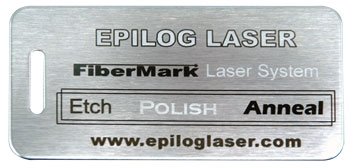Different Marks You Can Achieve with a fiber laser
How can I get different mark types on metal using a fiber laser?
There are many different applications or finished “looks” fiber laser systems were designed to achieve. All of these looks are created using various speed, power, frequency and focus settings on the fiber laser system.
Having an open-architecture system allows manufacturers to more quickly create exactly the mark they need because they’re using the design software with which they are already familiar.
The FiberMark laser is capable of producing a variety of marks on a wide variety of materials - bare metals, coated metals, anodized metals and plated metals can all be marked with incredibly fine detail. Color marks can also be achieved on certain metal types. Common and frequently used mark types include etching, polishing and annealing, which we'll describe below.

Etching is often used for industrial purposes – marking tools or parts with serial numbers, logos and bar codes. The etching process actually removes material from the metal. Material is removed to create whatever mark the user desires (barcode, data matrix code, etc.) Essentially, it is a shallow engraving that produces a high contrast mark in the metal.
Etching Settings:
- Speed: 8-30%
- Power: 100%
- Frequency: 1-10%
- Focus: -0.020" to +0.020"

Polished metal, or “mirrored” as it sometimes called, is a laser effect where the laser beam heats the surface of a material and as it cools, the material takes on a different finish. Most common on matte-finish metal, this technique creates marks that can look almost holographic.
Unlike etching, no material is actually removed from the metal being marked – it is the heat that alters the finish of the metal. Since the polished look emits a sense of sophistication and distinction, it is often used in architectural signage and labeling high-end products where a unique or aesthetically pleasing mark is necessary. The mirrored finish produces a tone-on-tone look where the metal has been marked.
This technique is also used on black oxide or similarly dark-coated metals. Using the settings below will result in a bleaching of the oxide/black coating to expose the color of the subsurface metal, again creating a contrasting tone-on-tone look.
Polishing Settings:
- Speed: 50-80%
- Power: 30-50%
- Frequency: 70-100%
- Focus: 0

An annealed mark is similar to the polishing process. The laser is used to heat metal to near melting points, which induces a color change to the top layer of material. Depending on the metal type, annealing often gives a dark, almost iridescent look. Similarly, FiberMark parameter setting can be used to intentionally produce distinct colors on certain materials.
Since no material is removed from the metal, this technique is often used for medical devices used within the human body. Annealing leaves no cuts or shallow engravings like those found in marking and etching and typically produces the darkest mark of these three methods.
Annealing Settings:
- Speed: 6-12%
- Power: 100%
- Frequency: 1%
- Focus: -0.060" to -0.090" or +0.70" to +0.010"

Check out our FiberMark whitepaper, which will give you a more comprehensive idea of the marks achievable with a FiberMark.
If further assistance is required, please visit www.epiloglaser.com/support to contact Epilog Laser Technical Support.